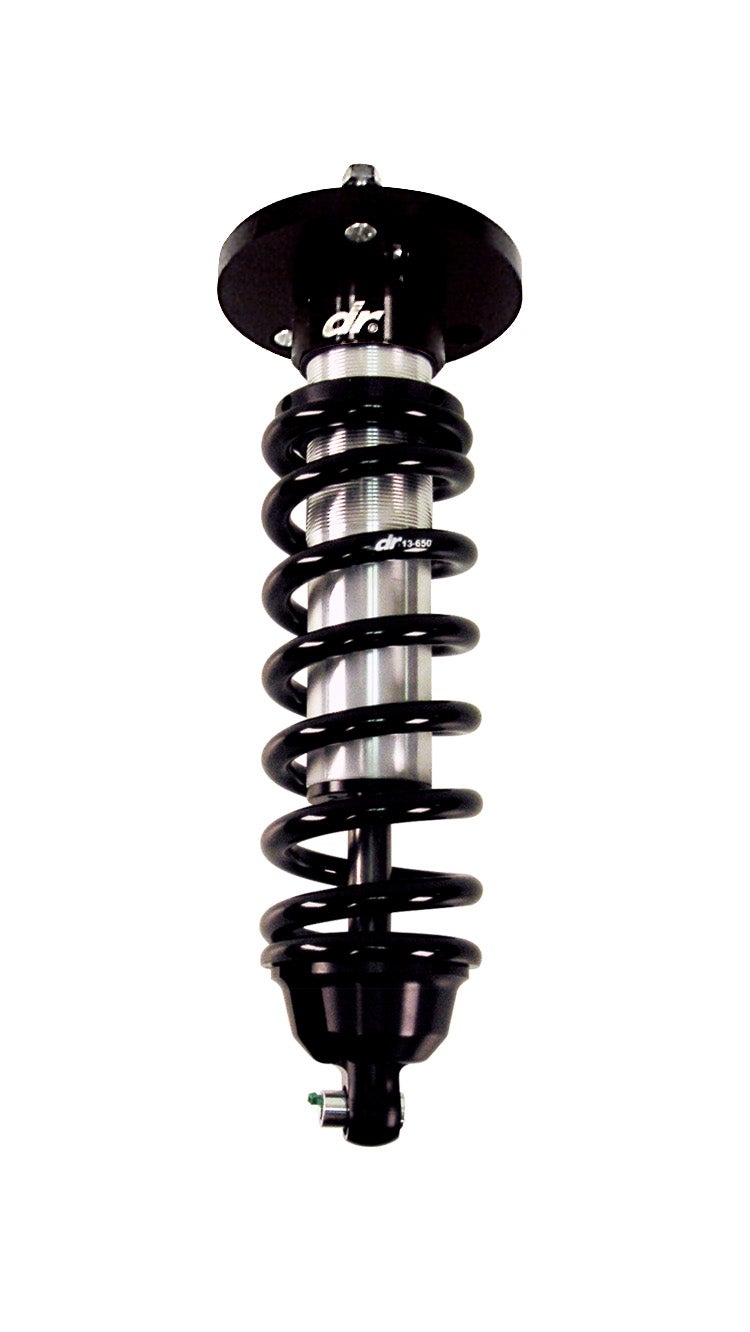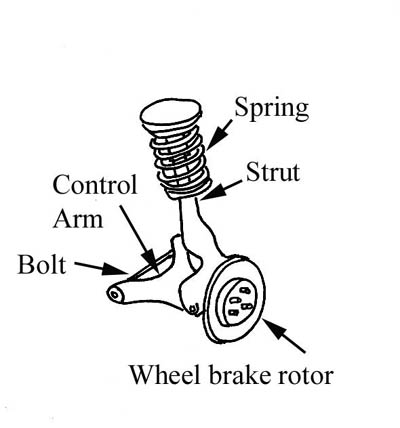Ok, first off id like to thank you guys for having me do this...i learned alot myself researching this.
To the guy with the suzuki, i would start off finding the air filter, usually under the seat, or towards the front of the engine. open that up, check to see if the filter needs replacing, and just follow that until you find a little box with some fuel lines coming to it. shut off the fuel (if there is a valve) and remove the fuel lines, not much fuel should spill out. remove the box, and take it apart being very careful not to lose parts, and to keep track of where everything went. clean everything thoroughly and put it back.
consider getting a "carb kit" for it, to help you out.
hope i diddnt miss any questions.
So about suspension. There are quite a few types, and all are different for certain applications of your vehicle.
lets start out simple (with cars, cause thats what i made the blog with the intentions of)
There is a part that most suspension units have, and what most people think of when they think of "suspension", this is the coil over. Basically a spring over a shock absorber. looks like the picture below. What it does is it provides resistance, yet ability for movement, all while preventing a pendulum effect, or stopping movement after the job is done.
the spring is the main resistance, and the shock (on the inside) dampens it.
many suspension types include this somewhere in their design, quite a fool proof design.
Now that we got the backbone for most suspension out of the way, lets start with the most simple suspension design, which ironically does not include the coilover.
The leaf spring suspension is one of the most common types, but also the most simple. You simply have a few slabs of metal clamped together that flex as a form of movement. This is classified as "dependent" because both wheels basically use the same unit. there is a solid axle that both wheels are attached to, then they are connected to one of these on each side, but as one goes up, the other will be at a different angle to the road, and might drive weird. trucks commonly have this, but cars almost never do.
as you can see, very basic, and not the best as a result.
with the solid axle idea, you can also replace it with a coil over, but it is more common for a leaf spring.
that is the basic idea of a dependent system, how about an independent system?
almost all cars have independent suspension systems, and their design is a bit more complicated.
the mcpherson strut is essentially the most straight forward independent system. you connect the wheel to the hub (what holds the wheel) and that is connect to a top and bottom piece.
the top piece is basically just made up of a coilover, but the bottom is connected to the frame, and holds most of the weight. we call the bottom piece the lower control arm, and it holds most of the weight, and force in this design.
as this is one of the most fool-proof designs of independent suspension, there are a few modifications to this design, some just moving the spring, and the angle, others tweaking the general idea.
another type is a double wishbone type suspension. This has the same idea of a top piece, and a bottom piece, called control arms.
one type of double wish bone has both control arms in the shape of a wish-bone (no way!), and the lower control arm has the coilover attached to it, with the upper control arm acting as reinforcement.
An alternative to this, is instead of the lower control arm being a wishbone shape, it is a single bar, and the upper control arm has the coilover attached to it. this transfers the load from the lower control arm, to the upper control arm.
a little less advanced is something called the "trailing arm" system. im going to be honest and i cant wrap my head around this. your upper and lower control arms are pieces of metal running parallel to the wheel, and attach to the chassis. the lower and upper control arms are parallel, and the lower carries the spring. *looks at picture one more time and figures out concept*
ok, now the end of the control arms attached to the wheel are attached to ball joints, and the other ends are pivot points. the allows for the wheel to move.
other components to suspension are such as sway bars, and...well thats the major one.
a sway bar just links the two sides of independent suspension together, making them move more as one, to...well...limit sway of the body.
interesting things i found during my research:
corvette uses a fancy suspension type that when first invented, was AWFUL, and hard to control, and just stupid.
this design combines the leaf spring idea, with the double wishbone design. (the one pictured below)
instead of the coilover being mounted to the lower control arm, just a shock absorber is mounted, and on the lower side of the lower control arm, is a leaf spring attached. this leaf spring runs along the bottom of the car, and the other end is attached to the other lower control arm.
after a little further research on this, it appears that the leaf spring in the corvettes are split in the middle, which gets rid of the problems of the original design.
the problem with the original design was under heavy braking, or a very sharp corner, the leaf spring would go to its unloaded position and i guess just make the car's contact with the road very little, and something like this would happen?
this took alot of thinking and research, and this post took about 2 hours to type..please enjoy haha
next post will be about the ajustments, modifications, and geometry of this whole setup, including but not limited to camber, caster, toe, scrub, and we will include some info on racing setup's.
Comment with any questions! :)







Woah, thats cool stuff. I always wish I knew more about how cars worked. I'll definitely be following!
ReplyDeleteNice breakdown of different suspension types, very informative.
ReplyDeletevery precise post. Even though I don't have a car right now, I'll just follow for the future.
ReplyDeleteLooks like you did a lot of research, good stuff.
ReplyDeleteVery nice explaining on types of suspension. A lot of engineering on these babies, huh?
ReplyDeleteWow interesting read. I now realize how little I know about suspension systems.
ReplyDeleteFeel like i was back in autoshop. :D
ReplyDeleteSick this is going to be super helpfull!
ReplyDeleteA lot of explanations, helped a lot
ReplyDeleteWow, you definitely know your stuff! Some pretty specialized stuff too, impressive.
ReplyDeleteI didn't know there were that many kinds. really informative.
ReplyDeletewow you really know your stuff man, sweet.
ReplyDeletevery informative, thanks for sharing. my skill in automotive assembly has increase by +1. :D
ReplyDeletefantastic review now I'm more clever
ReplyDeleteI found many Strut in the park trash can i wonder if they were aluminum so i can sell them.
ReplyDeletegood info, ive been wanting to read into how to change the suspension on my scion tc, just to lower it 1 1/2 -2"
ReplyDeletethey are absolutely not aluminum...that would break, and bend very easily
ReplyDeleteand they sell kits for suspension upgrades, you just get the correct one, and change the corresponding part.
be sure to check out my next post on what helps, doesnt help, and stuff like that to make sure you are doing it for the right reason
I'm getting my first motorbike in a few months and i really wanted to learn more about them.
ReplyDeleteThanks for the informative article!
;D
The amount of engineering that goes into suspension on cars is intense. All to hold it up and make it drive nice! Subbed, love the content!
ReplyDeleteI learned a lot, I don't know anything about cars
ReplyDeleteGave it another read!
ReplyDeleteAwesome blog man! Keep up the good work! It will pay off!
ReplyDeleteGood post mate, keep it up!
ReplyDeleteUnrelated Randomness
i forgot to go over bike's oops...:/
ReplyDeletesorry guys, i will include it with next post, along with the pictures hopefully
cool
ReplyDeletelots of very usefull information here!
ReplyDeleteim following and supporting from now on!
really informative, i learned a lot (i knew practically nothing). so thanks, following.
ReplyDeleteI wish I knew as much about cars as the author. All I can do is change oil and tires.
ReplyDeleteA++ Blog (:
ReplyDeleteVery informative, thanks!
ReplyDeleteyou know your parts!
ReplyDeleteWow this is quite interesting! Are you a mechanic by trade?
ReplyDeletePretty cool man.
ReplyDeleteWow have you ever thought about getting into mechanics/customization? my ex b/f once cut the roof off of his FTO coupe to turn into a ragtop, and the thing colapsed in the middle, total write off.
ReplyDeleteGreat post dude! Quite interesting stuff.
ReplyDeletereal interesting
ReplyDeleteReally interesting, keep up the good work.
ReplyDeletesuspensions seem like they dont work, and i dont know much about cars/ or trucks and i think tires should be all rubber, but thin, then they wont pop
ReplyDeletefollowing
So much info. I'd love to learn more about cars so I can work on them myself. great blog. followed
ReplyDeleteas a mech eng student this blog is of much interest to me, following
ReplyDeletethis did take a lot of research! nice post
ReplyDeleteI never thought I'd ever learn how suspension worked, but this is interesting. I've always been interested in Cars, and I'm looking forward to buying one soon. Great blog! Looking forward to more future informative posts.
ReplyDeletegreat read.
ReplyDeletePutting a new suspension on my BMW this week!
ReplyDeleteReally interesting stuff! I'm looking forward to this!
ReplyDeletevery informative, i'll follow
ReplyDeleteHuh, I had no idea
ReplyDeleteInteresting. I've always been kind of interesting about how cars worked, but not motivated enough to actually find out haha.
ReplyDeleteNice detailed post.
ReplyDeletewow I just learned more than I did in all of high school reading this post. Good stuff man.
ReplyDeletegood stuff there. ive always wondered how all that stuff worked thakns for the info
ReplyDeletefollowed.
next post is consisting of what i promised (geometry basically), and just answering questions also.
ReplyDeleteASK AWAY!
the pictures are of really high quality. nice work! following you.
ReplyDeleteI can finally become a better mechanic....finally! I'll feel like more of a man.
ReplyDeleteVery impressive and informative, followed! ;D
ReplyDeletewoah man, nice article you wrote!
ReplyDeleteI wish I knew a little more about cars.
ReplyDeletemy car needs new suspension
ReplyDelete